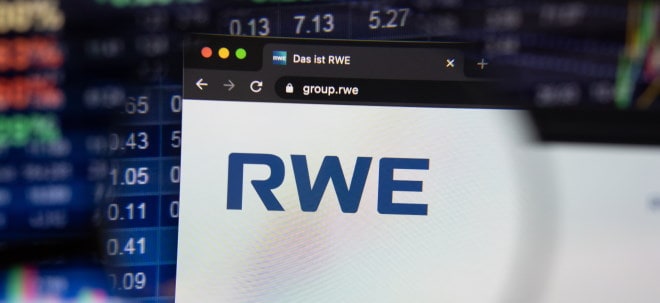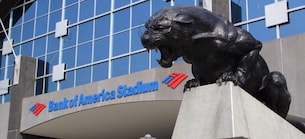Which Bank Stock to Buy as Fed Lowers Rate: Bank of America or Truist?
Werte in diesem Artikel
Bank of America BAC is one of the "Big Four" global banks, while Truist Financial TFC is a prominent regional bank. BAC leverages its massive scale, branch expansion strategy and diversified financial services, while TFC is blending its targeted regional branch expansion with cutting-edge digital banking. As the Federal Reserve has started an interest rate cut cycle, it is important to understand how these two large banks navigate the evolving operating environment. Let’s analyze Bank of America and Truist Financial’s business models to determine which one presents a solid investment opportunity.The Case for Bank of AmericaBank of America, one of the most asset-sensitive banks in America, is likely to witness a modest decline in net interest income (NII) over the medium term as the Fed continues to lower interest rates. Earlier this month, the central bank cut rates by 25 basis points (bps) and signaled two more this year amid easing inflation and a weakening labor market.The impact of the current rate cut cycle on BAC’s NII is likely to be minimal this year. The company projects NII to rise 6-7% in 2025, reaching $15.5-$15.7 billion in the fourth quarter, even if the central bank initiates rate cuts. This is based on the resilient consumer behavior and steady demand for loans.Moreover, Bank of America’s aggressive financial center expansion strategy across the United States will solidify customer relationships and tap into new markets, driving NII growth over time. The company continues to align its banking centers according to customer needs. These efforts, along with the success of the person-to-person money transfer system Zelle and the digital financial assistant Erica, will enable BAC to offer enhanced digital services and cross-sell several products, including mortgages, auto loans and credit cards. The shift toward easier monetary policy is expected to support client activity, deal flow and asset values. Thus, Bank of America’s non-interest income streams will likely see meaningful upside. Lower rates are expected to aid the company’s asset quality, as declining rates will ease debt-service burdens and improve borrower solvency. As the bank embarks on an ambitious expansion plan to open financial centers in new and existing markets, operating expenses are likely to remain elevated in the near term. BAC expects non-interest expenses to rise moderately in 2025.The Case for Truist FinancialUnlike BAC, Truist Financial is less sensitive to interest rate cycles. Since the divestiture of its insurance subsidiary in 2024, the company has been trying to strengthen its balance sheet through repositioning and making efforts to enhance its non-interest revenue sources.In August, TFC announced a growth plan – opening 100 new branches and renovating more than 300 existing locations in high-growth opportunity cities in the next five years and investing in its business banking ecosystem -- to capitalize on growth opportunities in dynamic U.S. markets while strengthening its digital capabilities.Additionally, the company is focusing on wealth management and expects a broad-based recovery in trading and investment banking businesses to drive non-interest income higher. This will also help alleviate Truist’s dependence on spread income to sustain top-line growth as rates come down.For 2025, TFC expects NII to grow almost 3% driven by loan growth and two 25-bp rate cuts alongside the benefits of fixed-rate asset repricing. Management expects to reprice nearly $27 billion of fixed-rate loans and securities in the third and fourth quarters of 2025.Like BAC, the company’s asset quality is expected to benefit from relatively lower rates. As Truist gets on with its branch expansion plan, upgrade technology and hire personnel to drive commercial banking business, operating expenses will likely remain high. The company expects adjusted non-interest expenses to rise approximately 1% this year.TFC & BAC: Price Performance, Valuation & Other ComparisonsThis year, TFC and BAC shares have risen 5.4% and 17.9%, respectively. Hence, in terms of price performance, Bank of America has a clear edge over TFC. Image Source: Zacks Investment ResearchIn terms of valuation, Truist is currently trading at a 12-month forward price-to-earnings (P/E) of 10.76X. BAC stock, in contrast, is currently trading at a 12-month forward P/E of 12.6X. Image Source: Zacks Investment ResearchSo, TFC is trading at a discount compared with Bank of America.Bank of America and Truist undergo annual stress tests conducted by the Fed before they can announce their capital distribution plans. Following the 2025 stress test, BAC hiked its dividend by 8% to 28 cents per share, while TFC maintained its dividend payout at the same level of 52 cents per share. At present, BAC has a dividend yield of 2.16% and TFC’s dividend yield is 4.55%. Hence, based on dividend yield, TFC has an edge over BAC. Image Source: Zacks Investment ResearchBank of America’s return on equity (ROE) of 10.25% is way higher than Truist’s 8.69%. This reflects BAC’s efficient use of shareholder funds in generating profits. Image Source: Zacks Investment ResearchHow Do Earnings Estimates Compare for TFC & BAC?The Zacks Consensus Estimate for BAC's 2025 and 2026 earnings indicates 12.5% and 15.9% growth, respectively. In the past week, Bank of America’s earnings estimates for 2025 have been revised upward, while for 2026, the same has remained unchanged. Image Source: Zacks Investment ResearchThe Zacks Consensus Estimate for TFC’s 2025 and 2026 earnings indicates a rise of 4.3% and 14.3%, respectively. Its earnings estimates for 2025 and 2026 have remained unchanged over the past seven days. Image Source: Zacks Investment ResearchBank of America or Truist: Which Bank Stock to Bet on?Given the Fed’s easing cycle, Bank of America looks better positioned to capitalize on lower rates through its scale, diversified income streams and ongoing branch expansion strategy. While near-term expenses may rise, BAC’s stronger earnings growth outlook, superior ROE and recent dividend hike signal financial strength and shareholder value creation. Its digital innovations and cross-selling opportunities also provide a long-term competitive advantage.Truist Financial, though less sensitive to rate shifts and offering a higher dividend yield, faces relatively modest earnings growth. Its discounted valuation and branch expansion strategy may appeal to value investors, but overall, Bank of America appears the stronger long-term bet.Currently, TFC and BAC carry a Zacks Rank #3 (Hold). You can see the complete list of today’s Zacks #1 Rank (Strong Buy) stocks here.Zacks' Research Chief Names "Stock Most Likely to Double"Our team of experts has just released the 5 stocks with the greatest probability of gaining +100% or more in the coming months. Of those 5, Director of Research Sheraz Mian highlights the one stock set to climb highest.This top pick is a little-known satellite-based communications firm. Space is projected to become a trillion dollar industry, and this company's customer base is growing fast. Analysts have forecasted a major revenue breakout in 2025. Of course, all our elite picks aren't winners but this one could far surpass earlier Zacks' Stocks Set to Double like Hims & Hers Health, which shot up +209%.Free: See Our Top Stock And 4 Runners UpWant the latest recommendations from Zacks Investment Research? Today, you can download 7 Best Stocks for the Next 30 Days. Click to get this free report Bank of America Corporation (BAC): Free Stock Analysis Report Truist Financial Corporation (TFC): Free Stock Analysis ReportThis article originally published on Zacks Investment Research (zacks.com).Zacks Investment ResearchWeiter zum vollständigen Artikel bei Zacks
Übrigens: Bank of America und andere US-Aktien sind bei finanzen.net ZERO sogar bis 23 Uhr handelbar (ohne Ordergebühren, zzgl. Spreads). Jetzt kostenlos Depot eröffnen und Neukunden-Bonus sichern!
Ausgewählte Hebelprodukte auf Bank of America
Mit Knock-outs können spekulative Anleger überproportional an Kursbewegungen partizipieren. Wählen Sie einfach den gewünschten Hebel und wir zeigen Ihnen passende Open-End Produkte auf Bank of America
Der Hebel muss zwischen 2 und 20 liegen
| Name | Hebel | KO | Emittent |
|---|
| Name | Hebel | KO | Emittent |
|---|
Quelle: Zacks
Nachrichten zu Bank of America Corp.
Analysen zu Bank of America Corp.
| Datum | Rating | Analyst | |
|---|---|---|---|
| 16.04.2024 | Bank of America Outperform | RBC Capital Markets | |
| 15.04.2021 | Bank of America Outperform | RBC Capital Markets | |
| 19.01.2021 | Bank of America Neutral | UBS AG | |
| 14.10.2020 | Bank of America Outperform | RBC Capital Markets | |
| 05.10.2020 | Bank of America Outperform | RBC Capital Markets |
| Datum | Rating | Analyst | |
|---|---|---|---|
| 16.04.2024 | Bank of America Outperform | RBC Capital Markets | |
| 15.04.2021 | Bank of America Outperform | RBC Capital Markets | |
| 14.10.2020 | Bank of America Outperform | RBC Capital Markets | |
| 05.10.2020 | Bank of America Outperform | RBC Capital Markets | |
| 18.06.2019 | Bank of America Outperform | BMO Capital Markets |
| Datum | Rating | Analyst | |
|---|---|---|---|
| 19.01.2021 | Bank of America Neutral | UBS AG | |
| 15.04.2020 | Bank of America Neutral | UBS AG | |
| 04.04.2019 | Bank of America Hold | HSBC | |
| 02.01.2019 | Bank of America Equal Weight | Barclays Capital | |
| 02.01.2018 | Bank of America Equal Weight | Barclays Capital |
| Datum | Rating | Analyst | |
|---|---|---|---|
| 21.12.2012 | Bank of America verkaufen | JMP Securities LLC | |
| 23.01.2012 | Bank of America verkaufen | Independent Research GmbH | |
| 27.10.2011 | Bank of America verkaufen | Raiffeisen Centrobank AG | |
| 20.10.2011 | Bank of America verkaufen | Independent Research GmbH | |
| 14.09.2011 | Bank of America verkaufen | Independent Research GmbH |
Um die Übersicht zu verbessern, haben Sie die Möglichkeit, die Analysen für Bank of America Corp. nach folgenden Kriterien zu filtern.
Alle: Alle Empfehlungen


